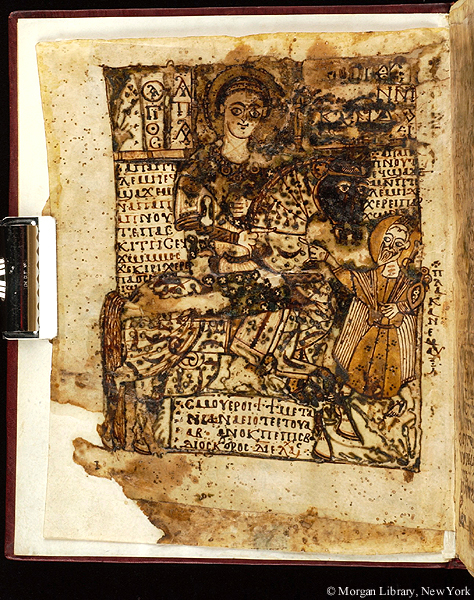
Manuscript written and illuminated in Egypt, between 800 and 920.
Colophon: 1) fol. 1v: Artist (and copyist?) in Coptic: By Deacon Dioskoros (not the same as copyist of M.663.1).
Written area ca. 253 x 197 mm. Divisions: Ekthesis, reddened greatly enlarged initial, and paragraphus sign (Touton style with budded diple in a [bud mostly reddened, diple sometimes, rarely both or none] and reddened obelus in b, rarely obelus and diple together or 2 diples) setting off paragraphs; 2 passages at fols. 13v, 25v marked by a small diple in margin of each line. Exceeding letters of last line of recto once written below end of the line and encompassed by a reddened stroke (fol. 25).
Script: Upright (title at fol. 2r right-sloping). 10 lines = ca. 88 mm
Superlineation: Non-standard (an unusual system of dots). Punctuation: Raised reddened dot (dot mostly outside reddening); sometimes space filler at ends of paragraphs. Tremas.
Collation: Signed on first and last page of the quire, top inner margin. Quire ornaments. No monograms, headlines or catchwords.
Artist: Dioskoros.
Decoration: Frontispiece on fol. 1v: Papnoute saluting Pteleme (who is mounted on horseback) and carrying his receptacle and another object in his left hand, at the top: "St. Apa Pteleme of Nikentori, 'Greetings'", and to the left of Pteleme: "Apa Pteleme speaking with Apa Papnoute the ascetic saying 'Greetings, Sir, my lord and father", and to the right of Pteleme, above Papnoute: "Apa Papnoute speaking with Pteleme, 'Greetings, O ruler'", and to the right of the receptacle: "the receptacle of water", and below the horse the colophon: By Deacon Dioskoros (artist and perhaps copyist). Headpiece on fol. 2r badly corroded but probably rectangular and infilled with knotted rope interlace, with spearhead finials, followed by title in a with curved line in margin, 3 dividers, major initial, vine-scroll coronis extending into tail margin, and 2 doves. Tailpiece ornaments on fol. 25v: a, 3 dividers, followed by a row of 6 multiple rules ending in a vertical stroke and alternating wih the diple crosses; b, 7 reddened dividers, followed by 4 multiple rules alternating with 3 diple crosses, all reddened. Marginal ornaments: head of fols. 4v, 7r, 10v, 11r: small ornament resembling quire ornament; tail of fol. 10r: quadruped (unicorn?), and fol. 19r: running hare, both with foliage in mouth. Quire ornaments: 4 small diples and a dot forming a cross (reddened). Initials: various initial infilled with crosses f diples, diples, dots, obelus, and/or triangles. Signatures and page numbers: with horizontal rule reddened above and below, decorated with dots to the left and an oblique obelus to the right. Extended letters. Colors: dark orange (Centroid 51), light olive brown (94).
Roughly a fourth of folios have sewing repairs (fol. 1 consists of 2 folios sewn together).
